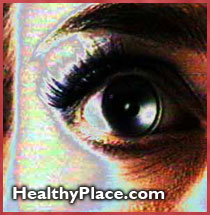Diagnostic Codes for Posttraumatic Stress Disorder (PTSD)
American Psychiatric Association
Diagnostic Criteria from DSM-III-R
- 309.89 Post-traumatic Stress Disorder / delayed onset
- 300.02 Generalized Anxiety Disorder
- 300.40 Dysthymia (or Depressive Neurosis)
- 307.10 Anorexia Nervosa
309.89 Post-traumatic Stress Disorder
A. The person has experienced an event that is outside the range of usual human experience and that would be markedly distressing to almost anyone, e.g., serious threat to one's life or physical integrity; serious threat or harm to one's children, spouse, or other close relatives and friends; sudden destruction of one's home or community; or seeing another person who has recently been, or is being, seriously injured or killed as the result of an accident or physical violence.
B. The traumatic event is persistently reexperienced in at least on of the following ways:
- recurrent and intrusive distressing recollections of the event (in young children, repetitive play in which themes or aspects of the trauma are expressed)
- recurrent distressing dreams of the event
- sudden acting or feeling as if the traumatic event were recurring (includes a sense of reliving the experience, illusions, hallucinations, and dissociative episodes , even those that occur upon awakening or when intoxicated)
- intense psychological distress at exposure to events that symbolize or resemble an aspect of the traumatic event, including anniversaries of the trauma
C. Persistent avoidance of stimuli associated with the trauma or numbing of general responsiveness (not present before the trauma), as indicated by at least three of the following:
- efforts to avoid thoughts or feelings associated with the trauma
- efforts to avoid activities or situations that arouse recollections of the trauma
- inability to recall an important aspect of the trauma (psychogenic amnesia)
- markedly diminished interest in significant activities (in young children, loss of recently acquired developmental skills such as toilet training or language skills) feeling of detachment or estrangement from others
- restricted range of affect, e.g., unable to have loving feelings
- sense of a foreshortened future, e.g., does not expect to have a career, marriage, or children, or a long life
D. Persistent symptoms of increased arousal (no present before the trauma), as indicated by at least two of the following:
- difficulty falling or staying asleep
- irritability or outbursts of anger
- difficulty concentrating
- hypervigilance
- exaggerated startle response
- physiologic reactivity upon exposure to events that symbolize or resemble an aspect of the traumatic event (e.g., a woman who was raped in an elevator breaks out in a sweat when entering any elevator)
E. Duration of the disturbance (symptoms in B, C, and D) of at least one month.Specify delayed onset if the onset of symptoms was at least six months after the trauma.
300.02 Generalized Anxiety Disorder
A. Unrealistic or excessive anxiety and worry (apprehensive expectation) about two or more life circumstances, e.g., worry about possible misfortune to one's child (who is in no danger ) and worry about finances (for no good reason), for a period of six months or longer, during which the person has been bothered more days than not be these concerns. In children and adolescents, this may take the form of anxiety and worry about academic, athletic, and social performance.
B. If another Axis I disorder is present, the focus of the anxiety and worry in "A" is unrelated to it, e.g., the anxiety or worry is not about having a panic attack (as in Panic Disorder), being embarrassed in public (as in Social Phobia), being contaminated (as in Obsessive-Compulsive Disorder), or gaining weight (as in Anorexia Nervosa).
C. The disturbance does not occur only during the course of a Mood Disorder or a psychotic disorder.
D. At least six (6) of the following eighteen (18) symptoms are often present when anxious (do not include symptoms present only during panic attacks):
Motor tension
- trembling, twitching, or feeling shaky
- muscle tension, aches, or soreness
- restlessness
- easy fatigability
Autonomic hyperactivity
- shortness of breath or smothering sensations
- palpitations or accelerated heart rate (tachycardia)
- sweating, or cold clammy hands
- dry mouth
- dizziness or lightheadedness
- nausea, diarrhea, or other abdominal distress
- flushes (hot flashes) or chills
- frequent urination
- trouble swallowing or "lump in throat"
Vigilance and scanning
- feeling keyed up or on edge
- exaggerated startle response
- difficulty concentrating or "mind going blank" because of anxiety
- trouble falling or staying asleep
- irritability
E. It cannot be established that an organic factor initiated and maintained the disturbance, e.g., hyperthyroidism, caffeine intoxication.
300.40 Dysthymia (or Depressive Neurosis)
A. Depressed mood (or can be irritable mood in children and adolescents) for most of the day, more days than not, as indicated either by subjective account or observation by others, for at least two years (one year for children and adolescents)
B. Presence, while depressed, of at least two of the following:
- poor appetite or overeating
- insomnia or hypersomnia
- low energy or fatigue
- low self-esteem
- poor concentration or difficulty making decisions
- feelings of hopelessness
C. During a two-year period (one-year for children and adolescents) of the disturbance, never without the symptoms in "A" for more than two months at a time.
D. No evidence of an unequivocal Major Depressive Episode during the first two years (one year for children and adolescents) of the disturbance.
E. Has never had a Manic Episode or an unequivocal hypomanic episode.
F. Not superimposed on a chronic psychotic disorder, such as Schizophrenia or Delusional Disorder.
G. It cannot be established that an organic factor initiated and maintained the disturbance, e.g., prolonged administration of an antihypertensive medication.
307.10 Anorexia Nervosa
A. Refusal to maintain body weight over a minimal normal weight for age and height, e.g., weight loss leading to maintenance of body weight 15% below that expected; or failure to make expected weight gain during period of growth, leading to body weight 15% below that expected.
B. Intense fear of gaining weight or becoming fat, even though underweight.
C. Disturbance in the way in which one's body weight, size, or shape is experienced, e.g., the person claims to "feel fat" even when emaciated, believes that one area of the body is "too fat" even when obviously underweight.
D. In females, absence of at least three consecutive menstrual cycles when otherwise expected to occur (primary or secondary amenorrhea). (A woman is considered to have amenorrhea if her periods occur only following hormone, e.g., estrogen, administration.)
next: How You React To Stress
~ all Holli's Triumph Over Tragedy articles
~ all abuse library articles
~ all articles on abuse issues
APA Reference
Staff, H.
(2009, March 21). Diagnostic Codes for Posttraumatic Stress Disorder (PTSD), HealthyPlace. Retrieved
on 2025, November 23 from https://www.healthyplace.com/abuse/articles/diagnostic-codes-for-post-traumatic-stress-disorder-ptsd




